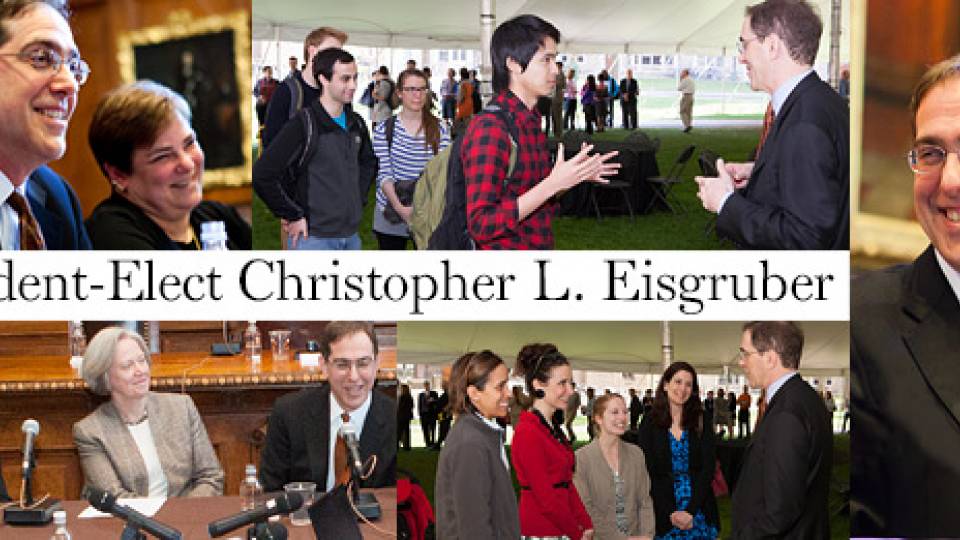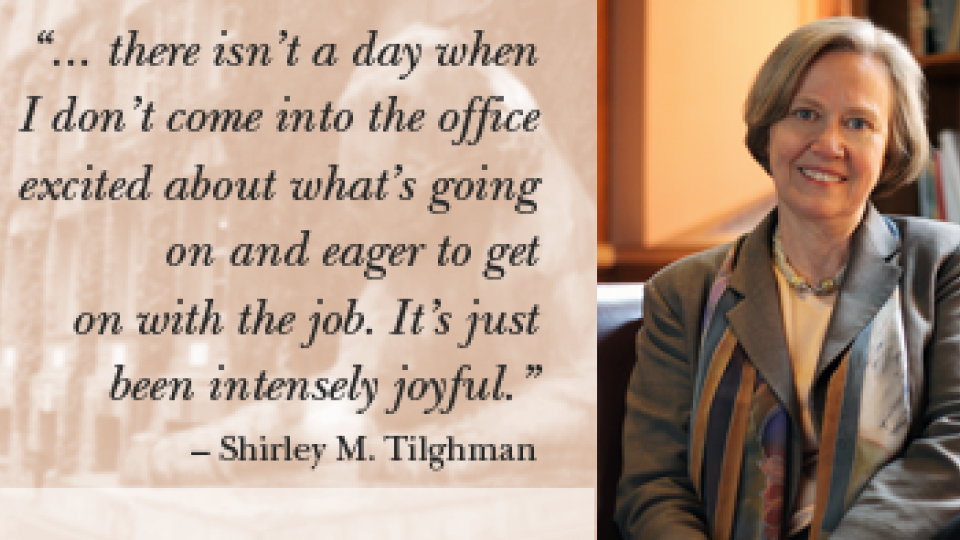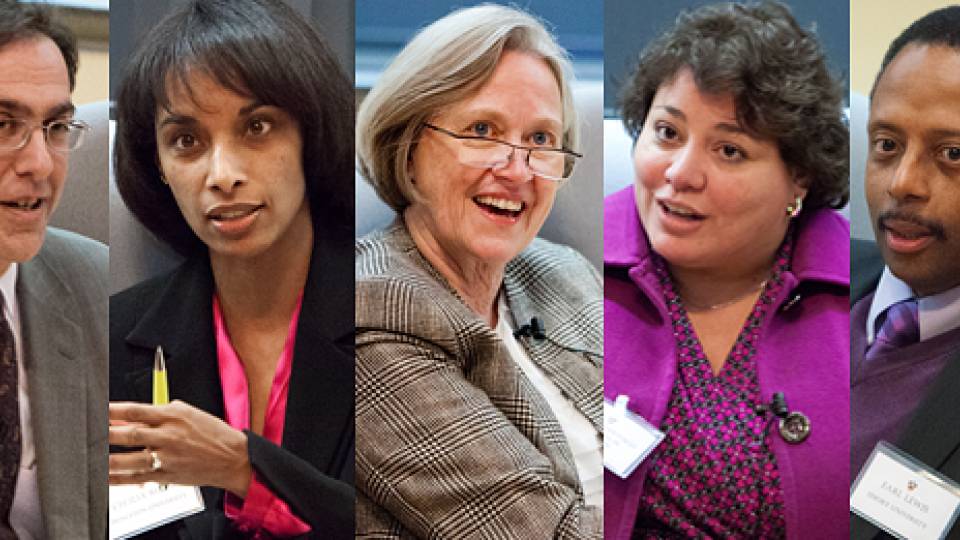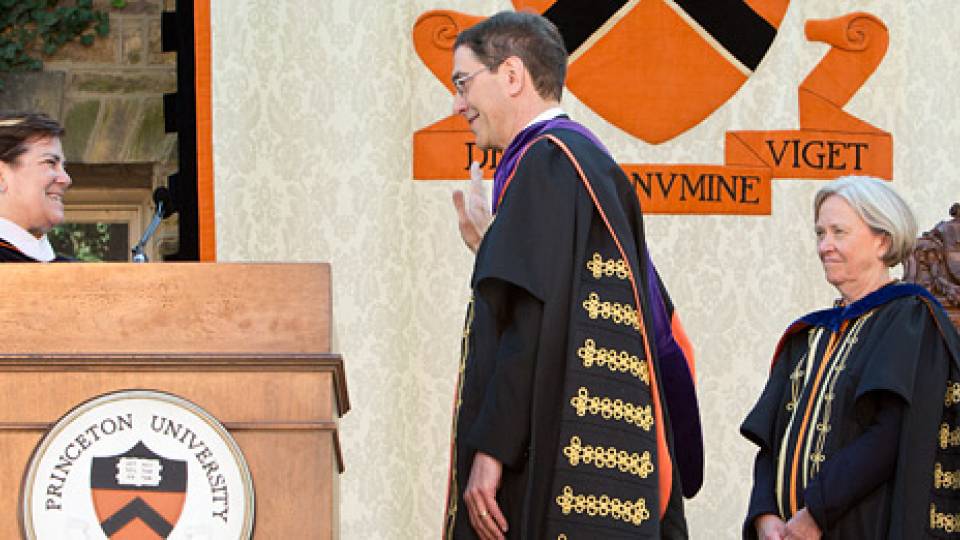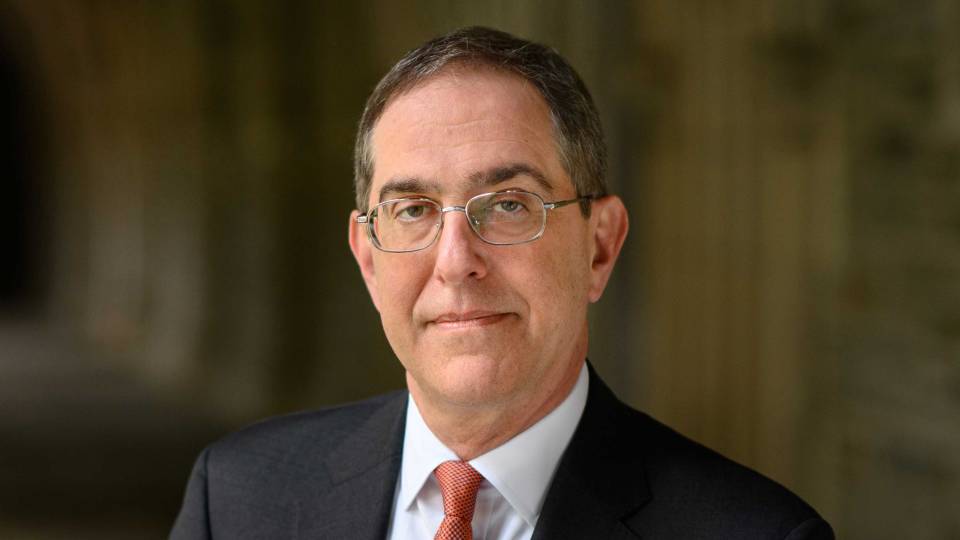Princeton University President Shirley M. Tilghman reflected on her 12 years leading the University and Provost and President-elect Christopher L. Eisgruber discussed his upcoming priorities and challenges on Saturday, June 1, as part of Reunions 2013.
In the hour-long conversation, Tilghman was the first to address the crowd of about 300 alumni and students in Richardson Auditorium in Alexander Hall. She was greeted with a standing ovation, and then spoke about how the University's strengths lie in how it balances tradition and leadership, and teaching and research.
Tradition "never gets in the way of our continuing to move and change and advance, and to be not just at the forefront of the scholarship but at the leading edge of it at times. How we do this — how we manage to balance a love of tradition and an aggressive approach to the future — I think it's one of the great strengths of the institution," said Tilghman, whose tenure as president ends June 30.
Tilghman noted that the balance between research and teaching enhances the work of faculty as well as the education of the University's students.
"I think it begins, quite honestly, with the senior thesis," she said. "The senior thesis makes all of us scholars, every one of us. Our students are scholars, our faculty are scholars — they are engaged in this common pursuit of new knowledge."
Tilghman touched on some of the physical changes to the campus during her time as president, such as the construction of two residential colleges, Whitman College and Butler College, and the ongoing construction of the Andlinger Center for Energy and the Environment and the Lewis Center for the Arts, which reflects Tilghman's initiative to make the arts a central part of Princeton's liberal arts education.
"For our students in particular, this is going to be transformative in the future," she said. "The arts are so alive and well on this campus. Our students are just bursting with creativity and imagination when it comes to the arts, and they needed a proper home, and they will have it."
In her closing remarks, she stated her confidence in Eisgruber's leadership and described her nine years working with him in his role as provost a partnership "you can only dream about."
Eisgruber, a 1983 Princeton alumnus, began his remarks with an anecdote about a surprise tribute to Tilghman at a recent faculty meeting. Eisgruber's appointment had just been announced, and Tilghman thought that the unusually large attendance was for Eisgruber, not for her — typical of her generosity of spirit, he said.
"One of the things that Shirley has taught me about being a university administrator and university president is she has said, the key to succeeding, if you are really succeeding on the University's behalf and doing these jobs right, is to take pleasure and to thrill at the success of others," Eisgruber said. "To recognize that … we are doing that on behalf of Princeton University; we are doing that on behalf of our alumni, our faculty, of course especially our students. It's their successes that matter."
Over the next year, as he begins to shape his own agenda, Eisgruber said, he will focus on four main items:
- continuing the projects and initiatives set in motion by Tilghman, such as the ongoing construction projects and the focus on expanding international study and partnerships;
- filling vacancies in the University administration, such as the provost position he will be vacating, and the executive vice president position that Mark Burstein will leave June 7 to assume the presidency of Lawrence University;
- conducting a listening and conversation tour with all University constituencies; and
- making sure Princeton plays a leading role in national and global conversations about higher education and liberal arts education in particular.
Eisgruber said the next decade will be challenging for liberal arts education because of a variety of public concerns: the costs of a university education; the value of a liberal arts education; calls for increased regulation; and new technologies such as online learning that could disrupt traditional models of higher education.
"I think we come at it with a lot of strength at Princeton, but I think it would be a mistake in the next decade for us to focus inwardly," he said. "The liberal arts mission that has mattered so much to all our lives matters to a lot of other students as well. It matters to more students than we could possibly accommodate on this campus. The only way this university can carry out its mission in the world is if we have a strong set of partner and peer institutions around the country."
Eisgruber then took questions from students and alumni, on topics such as online education, using technology to increase international perspectives in classes on campus, his worries for and about Princeton, students' well-being and admission policies.
Molly Alarcon, a 2010 alumna, said that she felt her admission to Princeton was a "golden ticket," and asked Eisgruber if he thought Princeton was diverse and open enough.
Eisgruber said that while the undergraduate student body is diverse across many categories such as race and religion, he hopes to expand its socioeconomic diversity. However, he noted the difficulty of increasing access of one group at the cost of another.
"We have so many extraordinary students on our campus I'd hate to lose any of those students," he said, adding that under Tilghman and president emeritus Harold T. Shapiro, now professor of economics and public affairs, the size of the each class has grown by 125 students to 1,300. "It always behooves us to be asking the question, 'Is it possible to say yes to a few more students?' rather than simply asking the question, 'Should we say yes to a different group of students?' because there are a huge number of kids who could benefit through the blessings that we enjoyed as Princeton undergraduates."
In addition, Eisgruber noted, a trustee committee has been studying how to enhance diversity in the faculty, graduate student body and senior administration. "I think that's important, too, because those places as well are important to allowing people to flourish as teachers, scholars and students," he said.
About 24,000 Princeton alumni, family and friends are on campus for Reunions, which began Thursday, May 30, and continues to Sunday, June 2. In addition to the event with Tilghman and Eisgruber, Reunions festivities included lectures and panels with alumni and faculty; community service projects; campus tours and open houses; a cappella, theater, dance and comedy performances by student groups; the annual P-rade through campus; and a Saturday evening concert and fireworks show.
